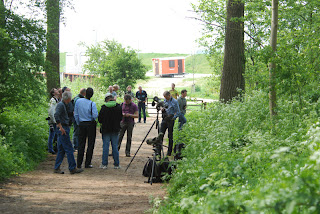Two days ago 2 Citrine Wagtails had been discovered at the Azewijnsche Broek, a great birding place south-east of Arnhem, close to the German border. Yesterday there was still one bird present (adult female). Tim de Boer sent a text message to our local 'message group' if anyone was interested to go with him, and ofcourse I was!;) So around 17:45 I drove to Tim's place from where we left to the Azewijnsche Broek. After one hour orso we arrived there. We parked the car a bit at the wrong place so we had to walk for 20 min, but who cares haha. On our way we saw 5 Whinchats. When we arrived there, there were 10+ birdwatchers present. The female Citrine Wagtail was foraging actively along the edge of the water, showing well. What a nice bird! Citrine Wagtails are not that easy to see in the Netherlands, certainly not in my province, so this was a nice oppertunity. It's my second Citrine Wagtail in the Netherlands, my first one was in 2008 (ironically also in my province), which was a 1st winter female in August. A Temminck's Stint (Gelderland-tick I think!) was also present there, together with 2 Wood Sandpipers and some Little Ringed Plovers. On our way back to the car we saw at least 31 Black Terns hunting above the big lake near of the Azewijnsche Broek. We heard that there was a Crane present, a kilometre away from the Citrine Wagtail palce, so on our way back to Apeldoorn we took a quick look and found the Crane immediatly, foraging.
A succesfull evening twitch!
This morning my dad and I decided to go to Kamperhoek, one of the best migration hots spots in the Netherlands in spring, in the province of Flevoland, 50 mins drive from Apeldoorn. The weather was great, but the wind direction spoiled the good migration, as - instead of a northeastern - we had wind coming from a northwestern direction. We did some hours of counting together with a few other birdwatchers. We still had some nice birds, such as 3 Merlins, 10 Whimbrels, 1 Garganey, 2 Green Sandpipers, 1 Wood Sandpiper, several Marsh Harriers, 1 Mediterranean Gull and migration of more common species, like Yellow Wagtails and Meadow Pipits. In the reedbed in front of the migration post there was a Savi's Warbler singing, continuously. On the Ketelmeer there was a huuge flock of ca. 800 Little Gulls, feeding and resting on the water. Probably the highest number of Little Gulls I've ever seen. Above that, all the birds were in summer plumage too, an extra!
While we drove back to Apeldoorn, along the Vossemeerdijk I saw an alert on my phone saying that a singing male Bonelli's Warbler had been found at Westervoort, a village near Arnhem, approximately 20 min driving from Apeldoorn. We decided to try for this bird as it's a very good bird in the Netherlands, even more so for the province! While driving back I discovered a nice hunting 2cy Red Kite, along the Vossemeerdijk.
Red Kite (Milvus milvus). My fair share of what a Red Kite looks like in flight ;) (Too bad I was only able to take a shot when the bird was really distant already...)
Around 12:15 we arrived at Westervoort. Seeing the number of cars we knew where we had to be. As I stepped out of the car I already heard the Bonelli's Warbler singing. Arriving at the crowd I could immediately look through a scope, to see the bird singing in a leafless tree, great! For the following 45 minutes the bird was singing actively and showing well every now and then. The bird is probably the Western Bonelli's Warbler (ssp. bonelli) but as for as I know the bird hasn't called yet, but the song has been recorded so as soon as there is a sonogram of the song we will know the species for sure :)
My terrible recordshots of the Bonelli's Warbler (Phylloscopus bonelli). On the last photo note the brownish tinge on the head, good for Western.
Twitchers at the Bonelli's Warbler, Westervoort.
A very good beginning of the month May!






Geen opmerkingen:
Een reactie posten